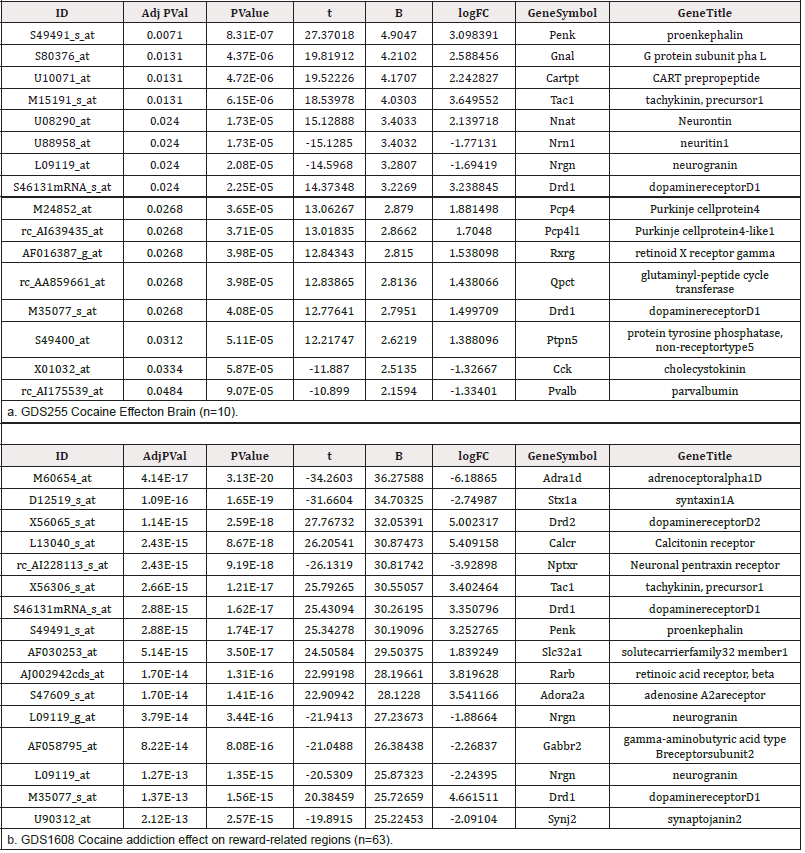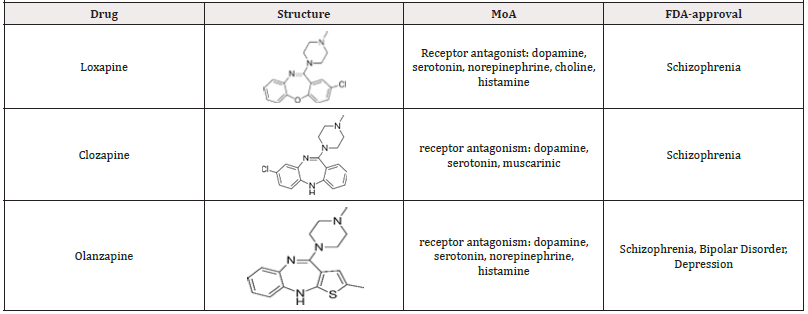Research Article 
 Creative Commons, CC-BY
Creative Commons, CC-BY
The Dopamine Receptor D1(DRD1) as a target for Developinga Therapy for Cocaine Addiction
*Corresponding author:Jill Harp, Winston-Salem State University Biomedical Research Infrastructure Center, USA.
Received:June 25, 2022; Published: July 08, 2022
DOI: 10.34297/AJBSR.2022.16.002271
Abstract
It takes approximately fifteen years and nearly one billion dollars to bring a drug to market. A computational approach shows promise in being used to find therapeutics in less time and cost-effectively [1]. The approach reported herein mines publicly available gene expression data to uncover a gene is up or down regulated from microarray experiments and may lead to the repurposing of a current Food and Drug Administration (FDA)-approved drug to help cure cocaine addiction. Publicly available data from National Center for Biotechnology Information (NCBI) Gene Expression Omnibus (GEO) repository (https://www.ncbi.nlm.nih.gov/geo/) was used. Data sets were downloaded to uncover the gene expression difference between saline and cocaine-treated rats and the top genes analyzed. The secondary analysis included the correlation with FDA-approved drug gene expression data found on the Broad Institute’s Connectivity Map (CMap: https://clue.io/cmap) website. This resulted in the identification of compounds that antagonize the dopamine receptor D1(DRD1).
Keywords: Connectivity Map, DRD1, Cocaine, Loxpine, Olanzapine, Clozapine, Gene Expression
Abbreviations: NAcc: Nucleus Accumbency; DRD1: Dopamine Receptor Type 1; PFC: Prefrontal Cortex
Introduction
Cocaine is a crystalline tropane alkaloid that blocks the Dopamine (DA), norepinephrine, and serotonin reuptake transporters (DAT, NET, and SERT). Cocaine’s addictive properties are ascribed to the DA reward system and because it blocks the DAT, it generates higher than normal concentrations of DA in the synapse and causes euphoria [2]. Cocaine addiction, a global health problem, warrants the development of behavioral therapies and medication(s). The purpose of this study is to discover a cocaine replacement treatment that can be used with behavioral therapies. It is hypothesized that relationships can be predicted between drugs and disease by comparing gene expression data of healthy and addicted subjects and correlate the differences with gene expression data from FDA-approved drugs. These predictions should give rise to potential therapeutics based on this correlation. The DRD1 is the most abundant dopamine receptor subtype in the central nervous system. It is a G-protein coupled receptor that stimulates adenylyl cyclase and activates cyclic AMP-dependent protein kinases. DRD1 regulates neuronal growth and development, mediates specific behavioral responses, and modulates dopamine receptor D2-mediated events. DRD1 is involved in cocaine’s reward mechanism and even an acute amount causes DRD1 to be activated [3-5].
Methods
The datasets (GDS 255 and 1608) [6] were accessed from the NCBI GEO site (https://www.ncbi.nlm.nih.gov/geo/). GEO2R analyses were conducted for the GDS255 (n=10) & GDS1608 (n=63) datasets, respectively, using the following parameters to compare the difference in gene expression of rat brain tissue from the Nucleus Accumbens (DA) and Prefrontal Cortex (5-HT): the Benjamin& Hochberg False discovery rate, auto-detected log transformation, and NCBI Platform annotations. A fold-change was regarded as significant with P<0.05. Lima precision weights and force normalization were not applied. The Top 250 Differentially Expressed Genes (DEGs) were further narrowed to the Top 16 DEGs. Each of the Top 16 DEGs were noted as up-regulated or down-regulated. Connectivity Map [7] used to uncover potential therapies based on the top genes analyzed at the NCBI GEO site and www.Clinicaltrials.gov was used to determine FDA-approved status of potential therapies.
Results and Discussion
Analysis of GDS 255 and 1608 with GEO2R revealed the top 250 genes impacted by cocaine treatment. Figure 1a and 1b are the volcano plots that show statistical significance (P value) versus magnitude of change (fold change). They depict what may be the most biologically significant genes when comparing the Nucleus Accumbency (NAcc) to the prefrontal cortex PFC in rats (Figure 1). The top 16 genes from the Volcano plot are shown in tabular form (Table 1). DRD1 is evident in the top sixteen most significant genes in both datasets. The Connectivity Map led to correlating drugs that target the DRD1 and provide therapeutic value. A total of 46 drugs were identified from the correlation with the majority (n=20) used for the treatment of schizophrenia. Figure 2 depicts loxapine [8], clozapine [9], and olanzapine [10]; these were chosen for further investigation due to their drug-gene interactions, and low abuse potential (Table 2). The piperazines, also classified as benzodiazepines, act at multiple sites (Table 3). These offtarget interactions explain the myriad of side effects individuals experience when taking these treatments. Structurally, it appears that replacing the ring oxygen with a nitrogen drastically reduced the number of side effects. Also, removing the Cl and replacing the benzene with a thipohene did not lead to a better medication. Hence, although these three drugs were chosen initially, it should be noted that other drugs exist that target DRD1. It should also be noted that dopamine’s transporter and other receptors could be targeted to find a treatment and the methods used at the GEO site should expand to address these sites (Table 3) [12].
Conclusion
DRD1 is a viable target for reducing cocaine-seeking behavior. Given the information regarding benzodiazepines that interact with this receptor, it appears that clozapine is superior due to the decreased number of side effects. Future Structure-Activity Relationship (SAR) studies may be needed and assist with uncovering a better pharmacotherapy for cocaine addiction.
Conflict of Interest
No Conflict of interest.
Acknowledgment
This research is supported by UNC Research Opportunities Initiative (ROI) award “Winston-Salem State University Center for Applied Data Science”, FY2020 – 2023.
References
- Chen B, Sirota M, Fan Minogue H, Dexter Hadley, Atul J Butte (2015) Relating hepato cellular carcinoma tumors mplesand celllinesusing gene expression data in translational research. BMC Med Genomics 8 Suppl 2(Suppl 2): S5.
- Volkow ND, Wang GJ, Fischman MW, Foltin R, Fowler JS, et al. (2000) Effects of route of administration on cocaine induced dopamine transporter blockade in the human brain. Life sciences 67(12): 1507-1515.
- Luo Z, Volkow ND, Heintz N, Pan Y, Du C (2011) Acute cocaine induces fast activation of D1 receptor and progressive deactivation of D2 receptor striatal neurons: in vivo optical microprobe [Ca2+] iimaging. The Journal of neuroscience: the official journal of the Society for Neuroscience 31(37): 13180-13190.
- Norimoto H, Fenk LA, Li HH, Tosches MA, Gallego Flores T, Hain D, et al.(2020) Aclaustruminre ptiles and its role in slow-wave sleep.Nature 578(7795): 413-418.
- Zingg B, Dong HW, Tao HW, Zhang LI (2018) Input–output organization of the mouse lustrum. Journal of Comparative Neurology 526(15): 2428-2443.
- Ahmed SH, Lutjens R, Vander Stap LD, Dusan Lekic, Vincenzo Romano-Spica, et al. (2005) Gene expression evidence for remodeling of lateral hypothalamic circuitry incocain eaddiction. Proc Natl Acad Sci U S A 102(32): 11533-11538.
- Lamb J, Emily D Crawford, David Peck, Joshua W Modell, Irene C Blat, et al. (2006) The Connectivity Map: Using Gene Expression Signatures to Connect Small Molecules, Genes, and Disease. Science 313(5795): 1929-1935.
- Shrestha S, Agha RS, Khan Z, Shah K, Jain S (2021) Considering Loxapine Instead of Clozapine: A Case Series and Literature Review. Cureus 13(1): e12919.
- Seeman P (2014) Clozapine, a fast-off-D2 antipsychotic. ACS Chemical Neuroscience 5(1): 24-29.
- Tollens F, Gass N, Becker R, Schwarz AJ, Risterucci C, et al. (2018) The affinity of antipsy choticdrugs to do pamine and serotonin 5-HT2 receptors determines their effects on prefrontal-striatal functional connectivity. Eur Neuro psycho pharmacology 28(9): 1035-1046.
- Bannon M, Johnson M, Michelhaugh S, Hartley Z, Halter S, et al. (2014) A Molecular Profile of Cocaine Abuse Includes the Differential Expression of Genes that Regulate Transcription, Chromatin, and Dopamine Cell Pheno type. Neuro psycho pharmacology : official publication of the American College of Neuro psycho pharmacology 39(9): 2191-2199.
- Robinson MJ, Robinson TE, Berridge KC (2014) 10 Incentive Salience in Addiction and Over-Consumption. The inter disciplinary science of consumption 185.







 We use cookies to ensure you get the best experience on our website.
We use cookies to ensure you get the best experience on our website.